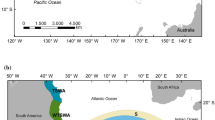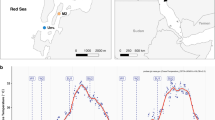Abstract
The global NaGISA (Natural Geography in Shore Areas) initiative focusing on long-term monitoring of coastal biodiversity has recently been expanded to the Mediterranean. On the basis of datasets from four Mediterranean hard substrate sites and by using the most abundant polychaete family (Syllidae), two questions are addressed in this study: (a) Is the biodiversity sampled in the two NaGISA sites, based on the family Syllidae, representative of the regional one of the Mediterranean Sea? (b) Are local syllid taxo-communities assembled at random from the regional species pool? Randomisation tests determining to what extent local species lists and their phylogenetic relationships are assembled at random from a regional one showed that at small observational scales (e.g. replicate units, depths) the phylogenetic diversity is assembled at random from the one known to exist locally. It is assumed, therefore, that local processes here have a stronger influence on community assembly than historical-evolutionary processes. The latter is in accordance with previous results derived from using polychaetes to test the same hypotheses at a pan-European level. Local syllid biodiversity in the western Mediterranean is a random subset of the Mediterranean one, whereas that of the NaGISA sites in the eastern Mediterranean is only under certain conditions. Therefore, the currently observed biodiversity of the Mediterranean sites can be considered as representative of that of the entire regional sea only under certain assumptions, as far as the syllid taxo-communities are concerned, demonstrating the potential of the taxon as a surrogate of the polychaete biodiversity.





Similar content being viewed by others
References
Aguado, M. T. & G. San Martín, 2007. Syllidae (Polychaeta) from Lebanon with two new reports for the Mediterranean Sea. Cahiers de Biologie Marine 48: 207–224.
Aguado, M. T. & G. San Martín, 2009. Phylogeny of Syllidae (Polychaeta) based on morphological data. Zoologica Scripta 38: 379–402.
Aguado, M. T., A. Nygren & M. E. Siddall, 2007. Phylogeny of Syllidae (Polychaeta) based on combined molecular analysis of nuclear and mitochondrial genes. Cladistics 23: 552–564.
Campoy, A., 1982. Fauna de Espana de Anelidos Poliquetos de la Peninsula Iberica. Publicaciones de Biologia de la Universidad de Navarra 7: 1–780.
Çinar, M. E., 2005. Syllis ergeni: a new species of Syllidae (Annelida: Polychaeta) from Izmir Bay (Aegean Sea, eastern Mediterranean Sea). Zootaxa 1036: 43–53.
Çinar, M. E. & Z. Ergen, 2002. Faunistic analysis of Syllidae (Annelida: Polychaeta) from the Aegean Sea. Cahiers de Biologie Marine 43: 171–178.
Çinar, M. E. & Z. Ergen, 2003. Eusyllinae and Syllinae (Annelida: Polychaeta) from northern Cyprus (Eastern Mediterranean Sea) with a checklist of species reported from the Levant Sea. Bulletin of Marine Science 72: 769–793.
Çinar, M. E. & M. C. Gambi, 2005. Cognetti’s syllid collection (Polychaeta: Syllidae) deposited at the Museum of the Stazione Zoologica “Anton Dohrn” (Naples, Italy), with descriptions of two new species of Autolytus. Journal of Natural History 39: 725–762.
Çinar, M. E., Z. Ergen & H. A. Benli, 2003. Autolytinae and Exogoninae (Polychaeta: Syllidae) from northern Cyprus (Eastern Mediterranean Sea) with a checklist of species reported from the Levant Sea. Bulletin of Marine Science 72: 741–767.
Clarke, K. R. & R. M. Warwick, 1998. A taxonomic distinctness index and its statistical properties. Journal of Applied Ecology 35: 523–531.
Convention on Biological Diversity, 1993. United Nations, Treaty Series 1760: 142–383 [available online at http://treaties.un.org/doc/Publication/MTDSG/Volume%20II/Chapter%20XXVII/XXVII-8.en.pdf].
Giangrande, A., M. Licciano & L. Musco, 2005. Polychaetes as environmental indicators revisited. Marine Pollution Bulletin 50: 1153–1162.
Gray, J. S., 1997. Marine biodiversity: patterns, threats and conservation needs. Biodiversity and Conservation 6: 153–175.
Iken, K. & B. Konar, 2003. Natural Geography in Nearshore Areas (NaGISA): the nearshore component of the Census of Marine Life. Gayana 67: 153–160.
Legendre, P. & L. Legendre, 1998. Numerical Ecology. Developments in Environmental Modelling, Vol. 20. Elsevier Scientific Publishers, Amsterdam.
López, E. & R. Gallego, 2006. Temporal variation of a syllid (Syllidae: Polychaeta) taxocoenosis associated with Stypocaulon scoparium Kützing (Stypocaulaceae: Phaeophyceae) in the western Mediterranean. Journal of the Marine Biological Association of the United Kingdom 86: 51–59.
Musco, L. & A. Giangrande, 2005a. Mediterranean Syllidae (Annelida: Polychaeta) revisited: biogeography, diversity and species fidelity to environmental features. Marine Ecology Progress Series 304: 143–153.
Musco, L. & A. Giangrande, 2005b. A new sponge-associated species, Syllis mayeri n. sp. (Polychaeta: Syllidae), with a discussion on the status of S. armillaris (Müller, 1776). Scientia Marina 69: 467–474.
Musco, L., A. Terlizzi, M. Licciano & A. Giangrande, 2009. Taxonomic structure and the effectiveness of surrogates in environmental monitoring: a lesson from polychaetes. Marine Ecology Progress Series 383: 199–210.
Nygren, A., 2004. Revision of Autolytinae (Syllidae: Polychaeta). Zootaxa 680: 1–314.
Ravara, A., G. San Martín & M. H. Moreira, 2004. Syllidae from the continental shelf off Aveiro (NW Portugal) with the description of a new species, Syllis licheri (Annelida, Polychaeta, Syllidae). Senckenbergiana Biologica 84: 1–11.
San Martín, G., 1984. Estudio biogeográfico, faunistico y sistemático de los poliquetos de la familia Silidos (Syllidae: Polychaeta) en Baleares. Publicaciones de la Universidad Complutense de Madrid, Madrid.
San Martín, G., 2003. Annelida Polychaeta II. Syllidae. In Ramos, M. A., et al. (eds), Fauna Iberica, Vol. 21. Museo Nacional de Ciencias Naturales, Madrid: 1–554.
San Martín, G. & E. López, 2000. Three new species of Syllis (Syllidae: Polychaeta) from Iberian coasts. Cahiers de Biologie Marine 41: 425–433.
San Martín, G., E. López & M. T. Aguado, 2009. Revision of the genus Pionosyllis (Polychaeta: Syllidae: Eusyllinae), with a cladistic analysis, and the description of five new genera and two new species. Journal of the Marine Biological Association of the United Kingdom 89: 1455–1498.
Sardá, R., 1985. Anelidos poliquetos del Estrecho de Gibraltar. I. Amphinomida, Spintherida y Phillodocida. Miscellània Zoològica 9: 65–78.
Somerfield, P. J., C. Arvanitidis, S. Faulwetter, G. Chatzigeorgiou, A. Vasileiadou, J. M. Amouroux, N. Anisimova, S. J. Cochrane, J. Craeymeersch, S. Dahle, S. Denisenko, C. Dounas, G. Duineveld, A. Grémare, C. Heip, M. Herrmann, I. Karakassis, M. Kedra, M. A. Kendall, P. Kingston, L. Kotwicki, C. Labrune, J. Laudien, H. Nevrova, A. Nicolaidou, A. Occhipinti-Ambrogi, R. Palerud, A. Petrov, E. Rachor, N. Revkov, H. Rumohr, R. Sardá, U. Janas, E. Vanden Berghe & M. Wlodarska-Kowalczuk, 2009. Assessing evidence for random assembly of marine benthic communities from regional species pools. Marine Ecology Progress Series 382: 279–286.
Tofts, R. & J. Silvertown, 2000. A phylogenetic approach to community assembly from a local species pool. Proceedings of the Royal Society B 267: 363–369.
Warwick, R. M. & K. R. Clarke, 2001. Practical measures of marine biodiversity based on relatedness of species. Oceanography and Marine Biology: Annual Review 39: 207–231.
Warwick, R. M. & P. J. Somerfield, 2008. All animals are equal, but some animals are more equal than others. Journal of Experimental Marine Biology and Ecology 366: 184–186.
Wilson, J. B. & H. Gitay, 1995. Community structure and assembly rules in a dune slack – variance in richness, guild proportionality, biomass constancy and dominance/diversity relationships. Vegatatio 116: 93–106.
Acknowledgments
The authors thank Dr. Thanos Dailianis, Wanda Plaiti, Panagiotis Vavilis and Dr. Elena Sarropoulou for assistance during SCUBA diving and obtaining samples, Manolis Pettas and Kostas Christodoulou for help in designing and constructing the sampling devices (frames and suction), Vasiliki Markantonatou for help in sorting the samples and Dr. Guillermo San Martín for assisting in finding suitable datasets and literature resources. The two anonymous reviewers are particularly acknowledged for their constructive comments and suggestions.
The datasets on which the current study is based on will be made available through the EMODnet (http://bio.emodnet.eu/) and MedOBIS (http://www.medobis.org) data portals.
Author information
Authors and Affiliations
Corresponding author
Additional information
Handling editor: Vasilis Valavanis
Rights and permissions
About this article
Cite this article
Chatzigeorgiou, G., Faulwetter, S., López, E. et al. Can coastal biodiversity measured in four Mediterranean sites be representative of the region? A test for the robustness of the NaGISA protocol by using the hard substrate syllid (Annelida, Polychaeta) taxo-communities as a surrogate. Hydrobiologia 691, 147–156 (2012). https://doi.org/10.1007/s10750-012-1065-5
Received:
Revised:
Accepted:
Published:
Issue Date:
DOI: https://doi.org/10.1007/s10750-012-1065-5




